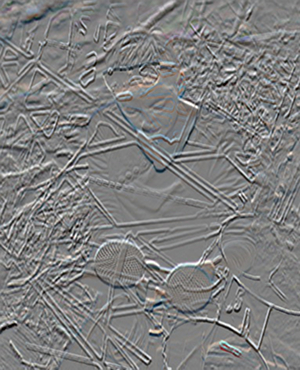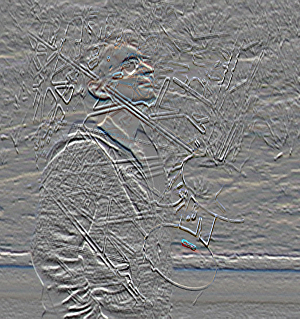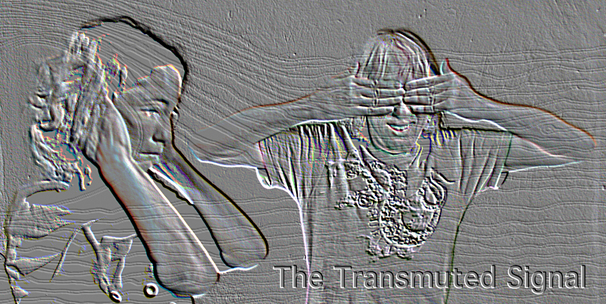Radio ist Kino im Kopf, sagt man. Beim
Zuhören entstehen Bilder in der Vorstellung der
Hörerinnen
und Hörer, insofern ist das Radio kein rein akustisches
Medium,
sondern hat auch visuelle Aspekte. Ebenso sind visuelle Medien nicht
allein auf die Wahrnehmung von Bildern beschränkt. In diesem
Sinn
gibt es keine Kommunikationsform, die ausschließlich einen
Sinn
anspricht. Es gibt nur unterschiedliche Gewichtungen von Standbildern
oder bewegten Bildern, von Sprache, Geräuschen, Musik,
taktilen
und anderen Erfahrungen.
Ausgehend von solchen Überlegungen haben die beiden
australischen
Künstler Colin und Yanna Black, die das Webradio-Projekt
Frequency
OZ betreiben, eine Radiokunst-Serie zusammengestellt, deren acht
Episoden im Februar und März in Kunstradio-Radiokunst zu
hören sind. Zu hören und zu sehen, um genau zu sein,
denn es
geht bei der Reihe “The Transmuted Signal” eben um
die
Übersetzung zwischen verschiedenen Modalitäten der
Wahrnehmung.
Wesentlich ist dabei, dass die originalgetreue Übersetzung
zwischen den Medien weniger von Bedeutung ist, als die
Veränderungen eines Originals und Abweichungen von diesem, die
mit
einem Umwandlungsprozess einhergehen.
Frequency OZ haben insgesamt acht Künstlerinnen und
Künstler
mit einem Bild konfrontiert, mit einem visuellen Signal also, das es zu
verschlüsseln und in eine akustische Form zu bringen galt,
sodass
die resultierenden Audioversionen miteinander verglichen werden
können. Im Anschluss wurden alle Teilnehmerinnen und
Teilnehmer
dieses künstlerischen Experiments gebeten, das impulsgebende
Bild
zu zerstören. Das Bild ist allein in seiner auditiven
Transmutation erhalten, in Form von acht Hörstücken.
Das Kunstradio sendet diese Stücke im Rahmen der Sendereihe
„curated by“, die vorsieht, dass
Künstlerinnen und
Künstler on air und online Ausstellungen neuer Radiokunst
konzipieren und zusammenstellen. In der Vergangenheit wurden dabei ganz
unterschiedliche Aspekte der Radiokunst untersucht und
herausgearbeitet, stets jedoch wird eine Erweiterung des
Hörraums
ins Internet und umgekehrt angestrebt. Durch die Beteiligung
internationaler Künstler, wie in diesem Fall Frequency OZ aus
Australien, werden immer wieder künstlerische Positionen
präsentiert, die in Österreich nicht bekannt sind.
Die Reihe
„The Transmuted Signal“, curated by Frequency OZ,
präsentiert Arbeiten von Entoptic, Nigel Helyer, Melanie
Herbert,
Cat Hope, Lizzie Pogson, Philip Samartzis und von Colin Black selbst.
In seinem Stück „Semblance“
(„Anschein“)
sucht Black die Unsichtbarkeit des Transformationsprozess eines Bildes
zu Sound so zu steigern, dass die Vielschichtigkeit des Bildes erhalten
bleibt. Freilich ist dies – wie Black rasch erkannte
– ein
subjektives und von künstlerischem Wollen nicht entleertes
Verfahren. Ebenso wie der Prozess der Umwandlung nicht umkehrbar ist.

Transductio
(13’29”)
by Lizzie Pogson
I felt my role in
this project was as an intermediary between the work at the point of
its digital birth and the audience’s reception of the work in
sonic form; to decode the image using my eyes and ears as vehicles for
a customized audience experience. This multilayered tangle of signs and
symbols has many possible meanings but the process of interpreting the
image (the ‘how’) was as interesting to me as the
interpretation itself. Were these objects (in the form of visual signs
and symbols) meant to manipulate my choices about motion, growth,
texture, behavior, noise, density and space? Or were they, as signs and
symbols more familiar to us in the real-world, more obvious? In the end
I went with gut instinct and chose to interpret the image not through
the meaning of its separate elements, but as interactive parts of a
whole.
The most obvious
idea to me was the natural vs the constructed (as seen by the
juxtaposition of the hand and the computer generated imagery) and I
could see an obvious alignment with my own art practice. My most recent
works have focused on the ambiguity created by combining modified field
recordings and computer generated sound, and so the play between the
natural and the constructed in the image was a logical starting point.
As an example, the hand in the centre of the image is distinct from its
surroundings. It has noticeably gone through some alterations but it
still retains an element of humanness and a connection back to the
unseen body. Its gesture of openness implies an intimacy with the
viewer and because of its digital alterations it becomes more
homogenous within its constructed environment. In correspondence with
the image the sound composition places natural sounds within artificial
environments and vice-versa; sounds that 'could' be natural and sounds
that 'could' be synthetic. Most of the changes between the the natural
and the synthetic are seamless, but at times there are abrupt switches
in context, highlighting the polarities between the black and the white
in the image. While the image is static, it signifies movement (as
implied by the flowing imagery in the background of the picture). The
hand is pushing forward from its surroundings to make contact with the
viewer and the listener is encouraged to engage with the sound
composition particularly in the opening section where the sound
material is more intimate in nature. The image is essentially becoming
activated through the use of sound and it no longer remains as just a
2D object. This idea of touch is threaded throughout the composition.
Sometimes it appears directly and sometimes as processed atmospheres.
I decided to use
the image to give me clues about shapes, textures, direction and speed
to use in the composition, but as I was avoiding looking at the signs
for direct interpretations, I used them instead to help me choose
sounds. I auditioned sounds while looking at various parts of the image
and chose the atmospheres according to intuition. Whether
it’s visual or sonic signs, intuition, motivations,
experiences, cultural context and knowledge or skills all play a role
in creating meaningful interpretations.

Flow
(31’12”)
by Philip Samartzis
The strange
NonAudioSignal schematic that I received for this project comprising a
handprint, wave patterns, and arcane symbols was initially viewed with
considerable speculation. At first I was struck by the peculiar
topography of signs and their potential link to ancient cultures
represented by the petroglyphs of Val Camonica, or the hand stencils of
El Castillo cave as early forms of ritual or cartography. However after
spending some time pondering the ambiguous nature of the schematic I
found myself thinking about the types of interventions that shape the
built and natural environment, and the human propensity for adaption
and survival. Hydroelectricity provides an extreme metaphor and system
to interrogate these complex relationships. Through massive earthworks
and complex technical infrastructure, pressurized water is mobilized to
generate the electricity required to power the spaces that we inhabit.
Following this train of thought it seemed appropriate that the
schematic be used to determine a work about the processes and
technologies used to create the energy necessary to produce an
electronic signal required for the construction and transmission of a
musical composition. A transmuted set of signals charting the
transformation of water into energy, of silence into signal.
For Flow I have constructed a work that investigates the Kiewa
Hydroelectric Scheme located in Alpine National Park in North East
Victoria, Australia. First developed in the 1930s, the hydroelectric
scheme is the first of its kind, and the second largest overall in
mainland Australia. Since its inception it has evolved to comprise four
power stations and attendant infrastructure including dams, rail
sidings, substations and networks of tunnels and aqueducts for the
generation, transmission and distribution of electricity. The scheme
begins at an altitude of 1800 meters at Rocky Valley and Pretty Valley
reservoirs where snowmelt is periodically released into an interlinked
series of power stations and dams distributed along the Kiewa Valley
starting with McKay Creek and followed by Bogong and Clover, concluding
with the West Kiewa power station at the foot of the mountains.
The resulting work comprises an assortment of field recordings of the
Kiewa Hydroelectric Scheme using various types of microphones to
capture air, water and structure based events. Through the support of
AGL Energy Limited I attained access to a range of infrastructure used
to exploit the gravitational force of falling or flowing water
including turbines, pumps, sub stations, dams and aqueducts to document
the distribution and conversion of water into electricity. The
composition is structured around an oblique framework in which various
field recordings are used to chart the collection and movement of water
through the length of the hydroelectric scheme. These movements are
bordered by pure sine tones – electrically generated sound
waves resembling simple wave patterns found in nature – that
function as an abstract corollary of the signs and symbols comprising
the NonAudioSignal schematic. The composition traces the containment
and circulation of water through the series of linked power stations,
before its eventual release into the Kiewa River, a major tributary
of the Murray River.
Credits
Assistant Sound Recordist: Madelynne Cornish
I would like to acknowledge the support of the following people and
organizations for the realization of this project.
AGL Hydro
Sarah McLeod
Bogong Centre for Sound Culture
Links:
http://www.frequencyoz.com
http://kunstradio.at/PROJECTS/CURATED_BY/OZ/
|



 Play
Play